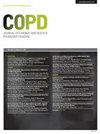Lack of Evidence Regarding Markers Identifying Acute Heart Failure in Patients with COPD: An AI-Supported Systematic Review
IF 3.1
3区 医学
Q1 Medicine
International Journal of Chronic Obstructive Pulmonary Disease
Pub Date : 2024-02-23
DOI:10.2147/copd.s437899
引用次数: 0
Abstract
Background: Due to shared symptoms, acute heart failure (AHF) is difficult to differentiate from an acute exacerbation of COPD (AECOPD). This systematic review aimed to identify markers that can diagnose AHF underlying acute dyspnea in patients with COPD presenting at the hospital.Methods: All types of observational studies and clinical trials that investigated any marker’s ability to diagnose AHF in acutely dyspneic COPD patients were considered eligible for inclusion. An AI tool (ASReview) supported the title and abstract screening of the articles obtained from PubMed, Scopus, Web of Science, the Cochrane Library, Embase, and CINAHL until April 2023. Full text screening was independently performed by two reviewers. Twenty percent of the data extraction was checked by a second reviewer and the risk of bias was assessed in duplicate using the QUADAS-2 tool. Markers’ discriminative abilities were evaluated in terms of sensitivity, specificity, positive and negative predictive values, and the area under the curve when available.
Results: The search identified 10,366 articles. After deduplication, title and abstract screening was performed on 5,386 articles, leaving 153 relevant, of which 82 could be screened full text. Ten distinct studies (reported in 16 articles) were included, of which 9 had a high risk of bias. Overall, these studies evaluated 12 distinct laboratory and 7 non-laboratory markers. BNP, NT-proBNP, MR-proANP, and inspiratory inferior vena cava diameter showed the highest diagnostic discrimination.
Conclusion: There is not much evidence for the use of markers to diagnose AHF in acutely dyspneic COPD patients in the hospital setting. BNPs seem most promising, but should be interpreted alongside imaging and clinical signs, as this may lead to improved diagnostic accuracy. Future validation studies are urgently needed before any AHF marker can be incorporated into treatment decision-making algorithms for patients with COPD.
Protocol Registration: CRD42022283952.
识别慢性阻塞性肺病患者急性心力衰竭的标志物缺乏证据:人工智能支持的系统性综述
背景:由于具有共同的症状,急性心力衰竭(AHF)很难与慢性阻塞性肺疾病急性加重(AECOPD)区分开来。本系统综述旨在确定可诊断急性呼吸困难的慢性阻塞性肺病患者急性心力衰竭的标志物:所有类型的观察性研究和临床试验,只要调查了任何标记物诊断急性呼吸困难 COPD 患者 AHF 的能力,均符合纳入条件。一种人工智能工具(ASReview)支持对从 PubMed、Scopus、Web of Science、Cochrane Library、Embase 和 CINAHL 获取的文章进行标题和摘要筛选,直至 2023 年 4 月。全文筛选由两名审稿人独立完成。数据提取的 20% 由第二位审稿人检查,并使用 QUADAS-2 工具对偏倚风险进行重复评估。根据灵敏度、特异性、阳性和阴性预测值以及曲线下面积(如有)对标记物的鉴别能力进行评估:搜索共发现 10,366 篇文章。经过去重后,对 5386 篇文章进行了标题和摘要筛选,剩下 153 篇相关文章,其中 82 篇可进行全文筛选。共纳入 10 项不同的研究(在 16 篇文章中报告),其中 9 项存在高偏倚风险。总体而言,这些研究评估了 12 种不同的实验室标记物和 7 种非实验室标记物。BNP、NT-proBNP、MR-proANP 和吸气下腔静脉直径显示出最高的诊断鉴别力:结论:在医院环境中使用标记物诊断急性呼吸困难的 COPD 患者的 AHF 的证据并不多。BNPs似乎最有前景,但应与影像学和临床体征一起解读,因为这可能会提高诊断准确性。在将任何AHF标记物纳入慢性阻塞性肺病患者的治疗决策算法之前,急需进行未来的验证研究:CRD42022283952。
本文章由计算机程序翻译,如有差异,请以英文原文为准。
求助全文
约1分钟内获得全文
求助全文
来源期刊

International Journal of Chronic Obstructive Pulmonary Disease
RESPIRATORY SYSTEM-
CiteScore
5.10
自引率
10.70%
发文量
372
审稿时长
16 weeks
期刊介绍:
An international, peer-reviewed journal of therapeutics and pharmacology focusing on concise rapid reporting of clinical studies and reviews in COPD. Special focus will be given to the pathophysiological processes underlying the disease, intervention programs, patient focused education, and self management protocols. This journal is directed at specialists and healthcare professionals
 求助内容:
求助内容: 应助结果提醒方式:
应助结果提醒方式:


